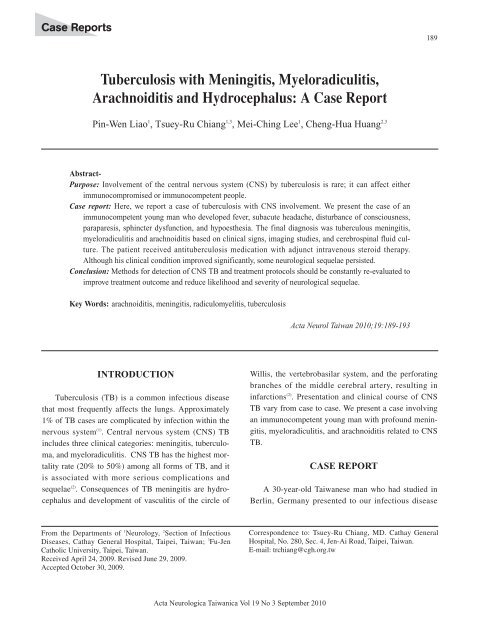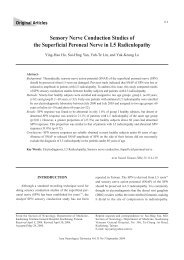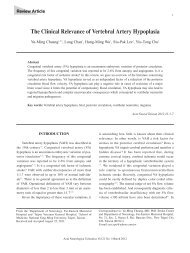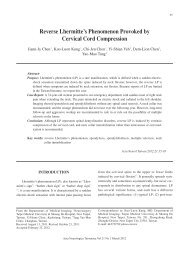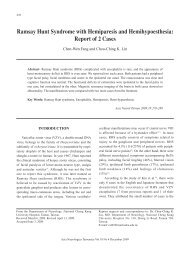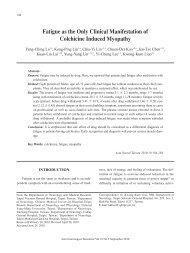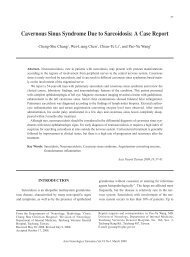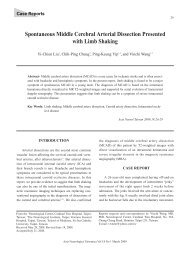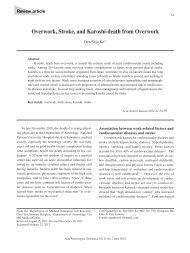Tuberculosis with Meningitis, Myeloradiculitis ... - Vol.22 No.1
Tuberculosis with Meningitis, Myeloradiculitis ... - Vol.22 No.1
Tuberculosis with Meningitis, Myeloradiculitis ... - Vol.22 No.1
You also want an ePaper? Increase the reach of your titles
YUMPU automatically turns print PDFs into web optimized ePapers that Google loves.
Case Reports189<strong>Tuberculosis</strong> <strong>with</strong> <strong>Meningitis</strong>, <strong>Myeloradiculitis</strong>,Arachnoiditis and Hydrocephalus: A Case ReportPin-Wen Liao 1 , Tsuey-Ru Chiang 1,3 , Mei-Ching Lee 1 , Cheng-Hua Huang 2,3Abstract-Purpose: Involvement of the central nervous system (CNS) by tuberculosis is rare; it can affect eitherimmunocompromised or immunocompetent people.Case report: Here, we report a case of tuberculosis <strong>with</strong> CNS involvement. We present the case of animmunocompetent young man who developed fever, subacute headache, disturbance of consciousness,paraparesis, sphincter dysfunction, and hypoesthesia. The final diagnosis was tuberculous meningitis,myeloradiculitis and arachnoiditis based on clinical signs, imaging studies, and cerebrospinal fluid culture.The patient received antituberculosis medication <strong>with</strong> adjunct intravenous steroid therapy.Although his clinical condition improved significantly, some neurological sequelae persisted.Conclusion: Methods for detection of CNS TB and treatment protocols should be constantly re-evaluated toimprove treatment outcome and reduce likelihood and severity of neurological sequelae.Key Words: arachnoiditis, meningitis, radiculomyelitis, tuberculosisActa Neurol Taiwan 2010;19:189-193INTRODUCTION<strong>Tuberculosis</strong> (TB) is a common infectious diseasethat most frequently affects the lungs. Approximately1% of TB cases are complicated by infection <strong>with</strong>in thenervous system (1) . Central nervous system (CNS) TBincludes three clinical categories: meningitis, tuberculoma,and myeloradiculitis. CNS TB has the highest mortalityrate (20% to 50%) among all forms of TB, and itis associated <strong>with</strong> more serious complications andsequelae (2) . Consequences of TB meningitis are hydrocephalusand development of vasculitis of the circle ofWillis, the vertebrobasilar system, and the perforatingbranches of the middle cerebral artery, resulting ininfarctions (2) . Presentation and clinical course of CNSTB vary from case to case. We present a case involvingan immunocompetent young man <strong>with</strong> profound meningitis,myeloradiculitis, and arachnoiditis related to CNSTB.CASE REPORTA 30-year-old Taiwanese man who had studied inBerlin, Germany presented to our infectious diseaseFrom the Departments of 1 Neurology, 2 Section of InfectiousDiseases, Cathay General Hospital, Taipei, Taiwan; 3 Fu-JenCatholic University, Taipei, Taiwan.Received April 24, 2009. Revised June 29, 2009.Accepted October 30, 2009.Correspondence to: Tsuey-Ru Chiang, MD. Cathay GeneralHospital, No. 280, Sec. 4, Jen-Ai Road, Taipei, Taiwan.E-mail: trchiang@cgh.org.twActa Neurologica Taiwanica Vol 19 No 3 September 2010
190clinic <strong>with</strong> fever and generalized weakness of five days’duration. Laboratory data (complete blood count <strong>with</strong>differential and chemical analysis) and urinalysis were<strong>with</strong>in normal limits, and chest X-ray showed no particularabnormalities. He was admitted to the infectiousdisease ward the following day. Ceftriaxone was startedas broad-spectrum coverage for suspected salmonellosis.Fever waxed and waned (peak, roughly 38.5˚C) duringthe initial days of admission and was accompanied by bydizziness, vomiting, and neck stiffness. Cerebrospinalfluid (CSF) study showed an opening pressure of 400mmH2O, white blood cell count 110/mm 3 (78% lymphocytes),protein 289 mg/dL, and glucose 29 mg/dL. CSFIndia ink stain, acid-fast stain, bacterial culture, cryptococcalantigen and bacterial antigen study (Escherichiacoli, Group B streptococci, Hemophilus influenzae) wereall negative. Serum testing for HIV and syphilis wasnegative; thyroid function and autoimmune profile were<strong>with</strong>in normal limits. TB meningitis was suspected. Onthe tenth day after admission, the patient developednumbness and weakness of his left leg. Myoclonus,bilateral hyperreflexia, and urinary retention were noted.The patient became agitated and irritable as symptomsprogressed. Brain magnetic resonance imaging (MRI)revealed leptomeningeal enhancement (Fig. 1) and mildhydrocephalus. Repeat CSF study showed an openingpressure of 235 mmH2O, white blood cell count 90/mm 3(75% lymphocytes), protein 2.3g/dL, glucose 49 mg/dL,and adenosine deaminase (ADA) 37 IU/L (0~20 IU/L).Treatment for highly suspected TB meningitis switchedto Rifater (120 mg rifampicin + 80 mg isoniazid + 250mg pyrazinamide) five tablets per day, ethambutol (400mg) 2.5 tablets per day and intravenous dexamethasone.Consciousness worsened to 11 points on the Glasgowcoma scale (E3M4V4), and the patient had a generalizedseizure on day 11 after admission. His breathing patternbecame shallow and he developed clinical signs andsymptoms consistent <strong>with</strong> the syndrome of inappropriateantidiuretic hormone secretion (serum sodium 118mmol/L, urine sodium 94 mmol/L, serum osmolarity249 osmol/kg, urine osmolarity 549 osmol/kg).Emergent brain computed tomography (CT) (Fig. 2)showed worsened hydrocephalus. External ventriculardrainage (EVD) was performed immediately to relieveCSF pressure. Level of consciousness improved dramaticallysoon after the emergent EVD procedure.Within three weeks of admission, muscle strength ofthe legs decreased to 1/5 (Medical Research Council[MRC] grade). The patient had reduced vibration, jointpositionand proprioception over both lower limbs andABFigure 1. (A, B) T1-weighted magnetic resonance images of the brain after administration of gadolinium contrast show mildleptomeningeal enhancement (arrow).Acta Neurologica Taiwanica Vol 19 No 3 September 2010
191Figure 2. Computed tomography scan of the brain on theeleventh hospital day shows dilatation of both lateralventricles (arrow).on the trunk below his mid-thoracic level. A band zonedermatome of hypoesthesia on the left side at T5-T6level was noted. Sphincter dysfunction, mainly severeurinary retention, persisted. CSF culture forMycobacterium (M.) tuberculosis was reported as positiveone month after initial examination. Diagnosis ofTB meningitis <strong>with</strong> myeloradiculitis and hydrocephaluswas confirmed based on culture results. Chest CTshowed no abnormalities. Serial serum HIV testing wasperformed for three consecutive months and all resultswere negative. Sputum culture was negative for tuberculosis.The patient’s fever subsided and his general conditiongradually improved after anti-TB medications werestarted. Two months after treatment, muscle strength inhis legs had improved to MRC grade 5/5. However,sphincter dysfunction and sensory impairment remained.Cervical-thoracic spine MRI revealed abnormallyincreased leptomeningeal enhancement <strong>with</strong> slight duralenhancement from the C7 to T10 levels (Fig. 3). Thepatient was treated <strong>with</strong> a anti-TB medication for a totalof 15 months under careful physician supervision.DISCUSSIONFigure 3. T1-weighted magnetic resonance image (sagittalview) of the cervical-thoracic spine after gadoliniumenhancement shows contiguous leptomeningealenhancement from C7-T10 levels (arrow).TB meningitis is the most common manifestation ofCNS TB, <strong>with</strong> clinical presentation often a subacutefebrile illness <strong>with</strong> generalized neurological syndrome.The British Medical Research Council devised a threestagesystem to assess severity of CNS TB (3) .Hydrocephalus may occur in the early or latent stage ofthe disease even after commencement of anti-TBdrugs (4,5) , and its management may influence prognosis (6-8). Our patient developed hydrocephalus <strong>with</strong> rapidchange in consciousness by the eleventh hospital day(grade III). He underwent EVD <strong>with</strong>out shunt surgery.The EVD procedure alone dramatically improved consciousnessand respiratory sufficiency. Subsequent brainCT showed resolution of the hydrocephalus.In CNS TB, the spinal cord can be affected by theinflammatory process and immune reaction (9) . Animmune response may proceed even after initiation ofanti-TB medication. As a result of these processes, thespinal cord is virtually strangulated due to progressiveActa Neurologica Taiwanica Vol 19 No 3 September 2010
192constrictive pial fibrosis (so-called spinal arachnoiditis)(10) . This is characterized on MRI by CSF loculations,obliteration of the spinal subarachnoid space, and thickened,clumped nerve roots in the lumbar region (11) .Contrast-enhanced MRI is helpful in differentiatingactive TB granulomatous disease from chronic fibroticadhesion. Chronic fibrotic tissue shows poor enhancementunder normal MRI (11) . Our patient started to havesymptoms of radiculomyelitis early in the course of hisCNS TB. Level of consciousness, fever and weakness ofthe legs all improved after treatment <strong>with</strong> anti-TB medicationand steroid. However, he still could not walk welldue to bilateral impaired proprioception, hyperreflexiaand clonus. Sphincter dysfunction remained. Follow-upcervical-thoracic spine MRI three months later revealedpersistent leptomeningeal enhancement at the cervicaland thoracic levels. The abnormal enhancement suggestsongoing inflammatory changes. Sequelae may beinduced by adhesive arachnoiditis, which causes irreversibledamage of the posterior column or secondaryaxonal damage of peripheral nerves. Recent medical literaturein the field of CNS TB research identified a phenomenonknown as the “paradoxical reaction” (PR) (12) .This phenomenon refers to observation of clinical orradiological worsening of previous TB lesions or developmentof new lesions after at least one month of TBtreatment in a patient who initially responded to anti-TBtherapy (12) . This PR may explain the abnormal enhancementsignals seen in our patient’s follow-up cervicalspineMRI. Adjunctive corticosteroid therapy is sometimesused in the management of PR (13) . Some authorsbelieve that steroid therapy is probably beneficial tocerebral and spinal edema and spinal block due to itsanti-inflammatory effects (14,15) . However, the benefit forPR very among different studies (13) . Our patient developedPR even though he received adjunctive steroidtherapy from the outset of anti-TB medication treatment.Although the incidence of TB infection is low indeveloped countries, maintaining a high degree of suspicionfor TB infection is vital in order to initiate therapyas soon as possible. From our case, we realized that M.tuberculosis can cause diffuse CNS infection in immunocompetentindividuals. In order to reduce likelihood ofcomplications and sequelae of CNS TB, we should makethe diagnosis as quickly as possible and initiate anti-TBmedication accordingly. Early EVD and shunt surgerymay prevent hydrocephalus and associated irreversibleneurological damage. Further advancement in earlydetection and diagnosis of CNS TB is valuable forphysicians in clinical practice. In conclusion, both methodsfor detection of CNS TB and treatment protocolsshould be constantly re-evaluated to improve treatmentoutcome and reduce likelihood and severity of neurologicalsequelae.REFERENCES1. Bradley WG, Daroff RB, Fenichel GM, Jankovic J Eds.Neurology in Clinical Practice. 5th Ed. : ButterworthHeinemann, 2008:1434-1438.2. Rock RB, Olin M, Baker CA, Molitor TW, Peterson PK.Central nervous system tuberculosis: pathogenesis and clinicalaspects. Clin Microbiol Rev 2008;21:243-261.3. Garcia-Monco JC. Central nervous system tuberculosis.Neurol Clin 1999;17:737-759.4. Chan KH, Cheung RT, Fong CY, Tsang KL, Mak W, HoSL. Clinical relevance of hydrocephalus as a presentingfeature of tuberculous meningitis. QJM 2003;96:643-648.5. Lan SH, Chang WN, Lu CH, Lui CC, Chang HW. Cerebralinfarction in chronic meningitis: a comparison of tuberculousmeningitis and cryptococcal meningitis. QJM 2001;94:247-253.6. El Sahly HM, Teeter LD, Pan X, Musser JM, Graviss EA.Mortality associated <strong>with</strong> central nervous system tuberculosis.J Infect 2007;55:502-509.7. Palur R, Rajshekhar V, Chandy MJ, Joseph T, Abraham J.Shunt surgery for hydrocephalus in tuberculous meningitis:a long-term follow-up study. J Neurosurg 1991;74: 64-69.8. Mathew JM, Rajshekhar V, Chandy MJ. Shunt surgery inpoor grade patients <strong>with</strong> tuberculous meningitis and hydrocephalus:effects of response to external ventriculardrainage and other variables on long term outcome. JNeurol Neurosurg Psychiatry 1998;65:115-118.9. Putruele AM, Legarreta CG, Limongi L, Rossi SE.Tuberculous transverse myelitis: case report and review ofthe literature. Clin Pulm Med 2005;12:46-52.Acta Neurologica Taiwanica Vol 19 No 3 September 2010
19310. Moghtaderi A, Alavi Naini R. Tuberculous radiculomyelitis:review and presentation of five patients. Int JTuberc Lung Dis 2003;7:1186-1190.11. Bernaerts A, Vanhoenacker FM, Parizel PM, Van GoethemJW, Van Altena R, Laridon A, De Roeck J, Coeman V, DeSchepper AM. <strong>Tuberculosis</strong> of the central nervous system:overview of neuroradiological findings. Eur Radiol 2003;13:1876-1890.12. Carvalho AC, De Iaco G, Saleri N, Pini A, Capone S,Manfrin M, Matteelli A. Paradoxical reaction during tuberculosistreatment in HIV-seronegative patients. Clin InfectDis 2006;42:893-895.13. Hawkey CR, Yap T, Pereira J, Moore DA, Davidson RN,Pasvol G, Kon OM, Wall RA, Wilkinson RJ. Characterizationand management of paradoxical upgrading reactionsin HIV-uninfected patients <strong>with</strong> lymph node tuberculosis.Clin Infect Dis 2005;40:1368-1371.14. Thwaites GE, Nguyen DB, Nguyen HD, Hoang TQ, DoTT, Nguyen TC, Nguyen QH, Nguyen TT, Nguyen NH,Nguyen TN, Nguyen NL, Nguyen HD, Vu NT, Cao HH,Tran TH, Pham PM, Nguyen TD, Stepniewska K, WhiteNJ, Tran TH, Farrar JJ. Dexamethasone for the treatment oftuberculous meningitis in adolescents and adults. N Engl JMed 2004;351:1741-1751.15. Hristea A, Constantinescu RV, Exergian F, Arama V,Besleaga M, Tanasescu R. Paraplegia due to non-osseousspinal tuberculosis: report of three cases and review of theliterature. Int J Infect Dis 2008;12:425-429.Acta Neurologica Taiwanica Vol 19 No 3 September 2010


